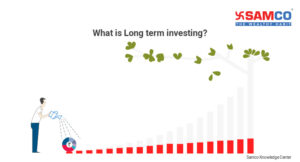 Health and wealth are the two most important parts of our lives. If you want to lead a healthier life, exercise is important. Whereas if you want to lead a wealthier life, long term investing is important.
But the question that arises is how long is long term investing? And how do you know the best approach for long term investing?
Don’t worry we have covered it all in this article!
So let’s begin.
Health and wealth are the two most important parts of our lives. If you want to lead a healthier life, exercise is important. Whereas if you want to lead a wealthier life, long term investing is important.
But the question that arises is how long is long term investing? And how do you know the best approach for long term investing?
Don’t worry we have covered it all in this article!
So let’s begin.
What is Long Term Investment?
Long term investing is building a roadmap for your future goals by investing in assets of different classes. These investment tenures can range from 3 years to more than 10 years.Why are Long Term Investments Considered so Powerful?
You must have heard about the saying, ‘Slow and steady wins the race.’ This is how long term investing works. It’s not about how to get quick money and easy returns. It’s more of how you choose the right investment option with the appropriate investment horizon and risk appetite. Moreover, by investing for the long term investors can get the benefit of Power of Compounding.What is Power of Compounding?
 Have you ever heard about the rice on the chessboard story?
If not, let’s have a quick summary.
There was a King who had a habit of challenging visitors who visited his palace for a game of chess. One day a sage kept a unique desire in front of him. He asked the king to place grains of rice in the following arrangement: 1 grain in the first square, 2 on the second, 4 on the third, 8 on the fourth and so on.
Soon the King realised that it is impossible to complete the chessboard as on the 20th square the king would have had to put 1,000,000 grains of rice! The king was astonished yet pleased and awarded the sage for his intellect.
The power of compounding is similar to the story above. It is all about letting your money stay invested for a longer period of time which gives it the effect of compounding. The interest you earn from your investments are reinvested and it becomes bigger and bigger.
Let us understand how the power of compounding works with the example.
Let’s say Anil and Sunil had invested Rs 5,000 per month for a period of 15 and 20 years respectively. What would be their total invested corpus with the effect of compounding?
Have you ever heard about the rice on the chessboard story?
If not, let’s have a quick summary.
There was a King who had a habit of challenging visitors who visited his palace for a game of chess. One day a sage kept a unique desire in front of him. He asked the king to place grains of rice in the following arrangement: 1 grain in the first square, 2 on the second, 4 on the third, 8 on the fourth and so on.
Soon the King realised that it is impossible to complete the chessboard as on the 20th square the king would have had to put 1,000,000 grains of rice! The king was astonished yet pleased and awarded the sage for his intellect.
The power of compounding is similar to the story above. It is all about letting your money stay invested for a longer period of time which gives it the effect of compounding. The interest you earn from your investments are reinvested and it becomes bigger and bigger.
Let us understand how the power of compounding works with the example.
Let’s say Anil and Sunil had invested Rs 5,000 per month for a period of 15 and 20 years respectively. What would be their total invested corpus with the effect of compounding?
| Investor | Anil | Sunil | Difference between the total corpus |
| Monthly Investment | 5,000 | 5,000 | - |
| Time Horizon | 15 years | 20 years | - |
| Rate of Return | 12% | 12% | - |
| Total Investment Amount | 9,00,000 | 12,00,000 | - |
| Compounding returns | 24,97,901 | 49,46,277 | Rs 24,48,376 |
1. Investment Objective
Before you invest for the long term, you need to understand your objective of investing. For example, you might want to make a retirement fund in the next 30 years or save for your child’s education in the next 10 years. Your long term would be equivalent to the time horizon you will need to fulfil your goal.2. Disposable income
Another important aspect that will help you analyse your long term is the disposable income you have in hand. Disposable income is nothing but the amount you are left with after spending. Knowing your disposable income will help you analyse how much amount you need to invest to accomplish your goal in the said time frame. According to the disposable income available, you will also be able to decide which investment will suit you the best.- High-risk
- Low-risk
- Medium-risk
3. Age
Taking your current age into consideration is very essential. It helps you analyse if the risk you are taking today is worth for the long term. If you are planning your retirement in your 30s, you can go for high risk investment options. Whereas, if you are in your 40s and are planning to gather funds for your child’s future education then medium to low risk option will help you reach your long term goal. In the end, there are no fixed rules for how long you should be investing. The only valid rule is, ‘The longer you hold, the better returns you get.’Which assets to buy for long term investing?
1. Equity shares
As you are looking for long term investing equity stocks are the best option for you. But, many people refrain from investing in stocks as they are considered risky. Let me tell you, Investment in stocks are not risky, the lack of knowledge makes it riskier. There are 2 keys to reducing risk in the stock market.- Diversification across different sectors.
- Pick stocks with strong fundamentals.
2. Mutual funds
There are 29 types of mutual funds but the two most popular among them are: 1. Equity Mutual Fund 2. Debt Mutual Fund Equity mutual funds invest a minimum 65% of the corpus in equity shares of companies. They have high risk high return associated with them. Debt mutual funds invest your corpus in fixed income securities such as treasury bills, government securities, short-term and long-term bonds, etc. They have low risk low returns associated with them. The biggest advantage of mutual funds is that your money is allocated based on expert research done by the fund manager. Here, the key to investing is taking a calculated risk that will provide you with better risk-adjusted returns.3. Public provident fund
Public provident fund is a 2 in 1 scheme. It helps you in save tax up to Rs 1.5 lakh under section 80C as per Income Tax Act and invest for the long term. PPF has a lock-in period of 15 years and is the best investment for low risk investors. You can also invest in PPF with the aim to diversify your risk.4. Gold
In the last 29 years (1991-2020), the prices of Gold have moved from Rs. 3,466 to Rs 51,000. Suppose in the year 1991 you had 70 grams of Gold in your locker. At that time it would have cost you Rs 24,262. But the value of the same gold today would be Rs 3,57,000. It is seen that as the rate of inflation rises, the prices of gold also rises. Hence, Gold is known as a hedge against inflation. Currently, you have these options to invest in gold for the long term.- Physical Gold
- Jewellery
- Gold Mutual Funds
- ETFs
- Sovereign Gold Bonds
5. Real estate
Real estate is a great option for long term investment but it is considered highly illiquid. To earn high returns, the location of your property is very essential. Ideally, real estate investment can deliver returns in 2 ways:- Capital appreciation of the property.
- The rent earned from the property.
| Investment options | Yearly returns | Liquidity | Tenure | Features |
| Stocks | 15% – 18% | Highly liquid | 5+years | Long term investment in stocks has provided inflation beating returns. You can diversify your portfolio across large-cap, mid-cap and small-cap stocks as per your risk profile. |
| Equity Mutual funds | 12% – 15% | Highly liquid | 5+years | Equity mutual funds are the most suitable long term investment for individuals with moderate-high risk. |
| Debt Mutual Fund | 5%-6.5% | Highly liquid | 5+ years | Debt mutual funds are suitable long term investment for individuals with low risk. |
| Public provident fund | 7% – 8% | Illiquid | 15 years | PPF are one of the safest long term investments with a low-risk appetite. |
| Gold | 9.27% (from 1991-2020) | Highly liquid | 5+years | Gold is considered a safe long term investment as it acts as a hedge against inflation. |
| Real estate | 7% – 9% | Highly illiquid | A longer holding period is recommended | The valuation of the property is dependent on its location. |
Final Thoughts
Who does not love high returns? But before you invest, you must also look for the risk you are taking to earn those returns. The best way to minimise returns is by diversifying your investment across asset classes. In this article, we have discussed the 5 Best long term investment options to invest. Few of them are high risk options, while few of them had low risk associated with them. A combination of both can definitely help you earn high returns over a longer period of time. You must be thinking, why Bank FDs have not been included in the list? There are 2 reasons.- A bank FD returns do not provide any tax benefit.
- It does not have the ability to fight against inflation as the current FD return rate has reduced to 5%.



 Easy & quick
Easy & quick
Leave A Comment?